|
part
4 lecture 12
Resonances between the three main impulses of the
3rd and 4th post-Atlantean epochs and
these impulses merging during the development of town culture
towards gold-gemstone art and continuing to work into the
5th epoch:
Ancient Christian sculpture
Sarcophagi and Reliefs
Bernward von Hildesheim
Dornach, 22. October 1917
Today I will introduce some observations and the way in which
these will be presented will appear to be more loosely
connected than those of the previous discussions which I have
been giving you during these past weeks. Despite the aphoristic
form in which I will speak today there is still a part for
future considerations; I'm thinking of the next time when it
will be possible to come back to some items which were attached
to these contemplations in order to arrive at a culmination, a
world view tableau, which I believe is necessary now, into
which the human being may be placed.
Today I would first like to show through some observations
which can't be supported by images — because I don't have
images to illustrate this — how within history, within Europe's
unfolding evolution during the last two to three centuries the
most varied impulses worked together, impulses of a threefold
nature. There were of course actually an infinite number of
impulses but it is actually sufficient to look at particular
elements which are the closest to reality in these
impulses.
We
live in the 5th post-Atlantean epoch. We stand in
this epoch which expresses itself outwardly in many
antagonistic and battling impulses these days. We live right
inside many things which admonish mankind to be ever more and
more awake for what is happening around us. One can say that
never in the unfolding of history, as far as it can be
researched, is mankind so called upon to wake up. In no other
time had mankind shown such sleepiness as in ours. In this
5th post-Atlantean time with its particular impulses
which we have come to know through our anthroposophical
considerations, there play echoes of the 4th
post-Atlantean time into it, but also echoes of the
3rd post-Atlantean epoch. Inside all that is
bristling and playing in our present events we can distinguish
between various things but today we will focus from a
particular viewpoint on three principal impulses, echoes of the
3rd and 4th post-Atlantean epochs and how
these work on our present 5th post-Atlantean
epoch.
In
the 4th post-Atlantic epoch one element asserted
itself in particular — here we approach the development in art
for our observation — in particular, and most valid, in
artistic development's depiction was what there was to be
discovered within the human being him- or herself. The Greeks
and after them the Romans strived to present time and space as
experienced within themselves as part of being human. We know
why this is so; we have often considered this. In other
cultural forms of the 4th post-Atlantean epoch, the
Greek-Latin time, this also revealed itself and we find it
expressed particularly in art. As a result, in the Greek time
period typical individuals were idealized and particularly
elevated in art. One could say the highest, most elevated form
which could be found in the sense world were the beautiful
people who took on such attractive forms and wandered around at
that time, in the most beautiful movements in the widest sense
of the word — Hellenism strived to depict them this way. During
no other time of earth's development can such a similar
striving be found; because each epoch of the earth's evolution
has its particular impulse.
Within this representation of the beautiful humanity of the
4th post-Atlantean time was a resonance from the
3rd post-Atlantean time. This echo was not limited
to a particular territory but rayed out over the cultural world
of the 4th post-Atlantic epoch. Thus one can say:
the 3rd post-Atlantean epoch became particularly
active by influencing the 4th post-Atlantic epoch
and continued to be active, even though it was now a weak echo,
in the 5th post-Atlantean epoch.
As
Christianity and the Christ impulse spread, it had to deal with
these interweaving impulses. Art impulses simply could not
unfold in the 3rd post-Atlantean time on the
physical plane as was the case in the 4th
post-Atlantean time, because even in the 4th the
depiction of the physical world was granted through beautiful
people, in beauty humanity was created. The 3rd
post-Atlantic epoch had to express many more, even if they were
atavistic, internalized impulses. In order to bring this about,
it had been necessary to reach back to grasp this kind of
impulse from the 3rd post-Atlantean epoch, in a
certain sense. Thus we see, while the Christ impulse spread
through the world, the artistic depiction of beauty within
humanity reaches back, and sometimes has an impact which is
like a kind of renewal of an impulse from the 3rd
post-Atlantean epoch.
The
Greek impulse which brought art to such a blossoming, quite
within the style and sense of the 4th post-Atlantean
epoch, had to preferably be limited to express growing,
flowering and thriving. Beauty for the Greeks was never
adornment. The idea of embellishment was unknown to the Greeks.
The Greek had the idea of everything alive, growing and
flourishing. The idea that embellishment could be added was
something which came much later into the world again, namely in
the continuing cultural development. The idea to which the
Greek world was the furthest removed can perhaps be found in
the word “elegant”. Elegance was unknown to the
Greeks — elegance which the living used to bedeck themselves
with adornments so that they would “shine” on the
outside — this was unknown to the Greeks. The Greek only knew
form and expression as originating from what was alive
itself.
The
impulses of Christianity also represented death; the Greek
epoch mainly represented all that sprouted, grew, and was
life-giving. The Cross of Golgotha had to stand opposite
Apollo. Yes, this was the great task of humanity, the great
artistic work of humanity, to work against death, in other
words all that could come from the world beyond because
Hellenism regarded ideals sensually represented as its highest
accomplishment.
This becomes obvious in all that is juxtaposed in an artistic
expression. This is evident when one sees how artistic skill
strived to express the beautiful, growing and blossoming,
youthful and prosperous people. This artistic skill brought the
Greek-Latin time particularly far. One can also see how
Hellenism was already growing in the first artistic Christian
creations, but how simultaneously these artistic creations
struggled with what couldn't be captured in the physical world
or dealt with artistically. As a result, we see how the
perfection of the representation of youth, vitality and
prosperity is placed beside the still clumsy representation of
death, eternity, including infinity which is the door to it
all.
I
have put together two motifs from the ancient Christian art of
the first centuries, to illustrate what I'm trying to present.
Firstly, the “Good Shepherd”:
661
Statuette of the Good Shepherd (Rome, Lateran Museum)
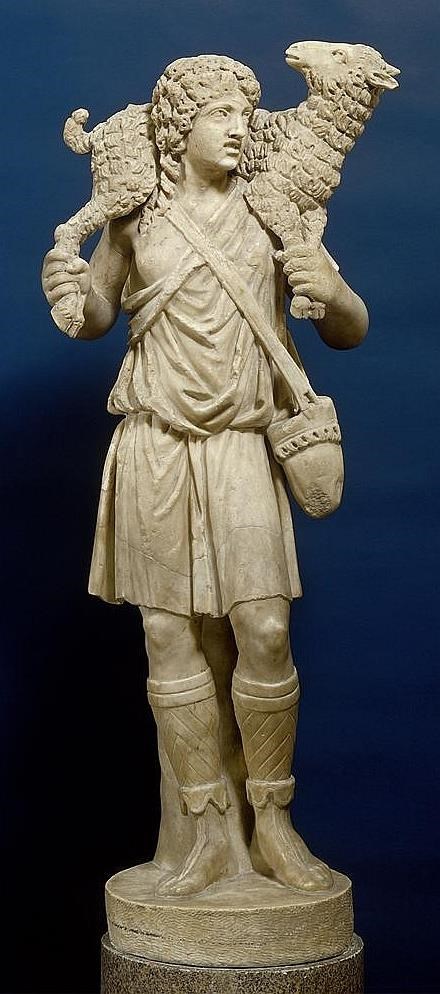
...
a statue to be found in Lateran, in which you can see how the
artistic skill is presented in the growing, blossoming and
prospering element, the vitality as it grows within the
Christian art; if one believes that the Jesus figure is linked
to the “Good Shepherd”. Greek art was dedicated to
life, dedicated to depicting the world of the senses with the
human being as the highest accomplishment of life, who in death
will grasp the consciousness which alone will give access to
infinity, eternity, and the supernatural. One can see how they
tried to adapt this to Apollo, Pallas Athene and Aphrodite who
really represented youthful blossoming, growing and thriving,
how this development wants to merge with the other form, yet
still holding on to the striving in the artistic sense, with
death, the infinite, towards the supernatural. This is the echo
in art which came out of the sense world and became the
magnificent flowering in the 4th post-Atlantic
epoch.
Now
we take another artwork carved out of wood — coming from about
the same time period — the representation of the crosses on
Golgotha:
662
Crucifixion, Relief, Wood — a door in Santa Sabina, Rome.
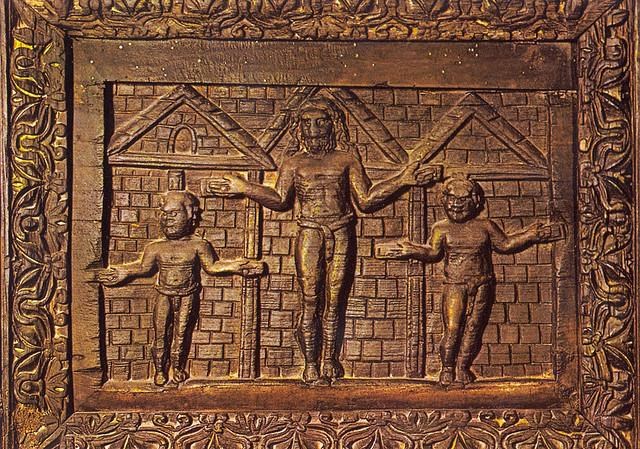
Christ on the cross, between the two thieves.
If
you look at it you realize how unskilful it looks in comparison
with the previous image (661). The mystery of Christianity
could not be mastered artistically, it still had the work of an
entire century ahead. During the very first centuries of
Christianity one finds such inadequate representations of the
central mystery of Christianity.
One
can already say that these things should not be taken up in the
sense of false aesthetics or in hostility towards sensory
impressions, because the gaze, the soul gaze during the first
Christian times was focussed on the mystery of death, which had
to be validated in a super-sensory way through knowledge of the
Mystery of Golgotha. By believing one is connected to the
mystery of Golgotha, it was believed that one could grow into
feelings and experiences and see the infinite validity of the
human soul which lay behind the door of death. No wonder that
as a result, in the field of the most varied cultural forms of
worship of the dead during the first centuries this was
particularly noticeable in sensitive Christians. So you see why
this characteristic style which I want bring into expression is
directly linked for you in the Good Shepherd (661) to this
“Representation of the Mystery of Golgotha” (662).
Thus we see the characteristic style in the artistic creations
of the first Christian centuries depicted in reliefs and most
of all in the carved reliefs found in sarcophagi. The dead, the
remains of the dead, memories of the dead combined in the
sarcophagus, are linked to the Mystery of the Dead, this was a
profound need of the first sensitive Christians. The secrets of
the Old and New Testament were the favoured elements to be
depicted on the walls of the sarcophagus. To study the
sarcophagus art of the first Christian centuries in particular,
means to delve into what was being done in Christianity, to a
certain extent the Mystery of Death is also there, where it
shows itself in reality: with the sarcophagus, expressed
artistically with the mystery of death, it is brought together
with the knowledge of the revelation of everlasting life, with
biblical mysteries.
The
door in Santa Sabina, Rome:
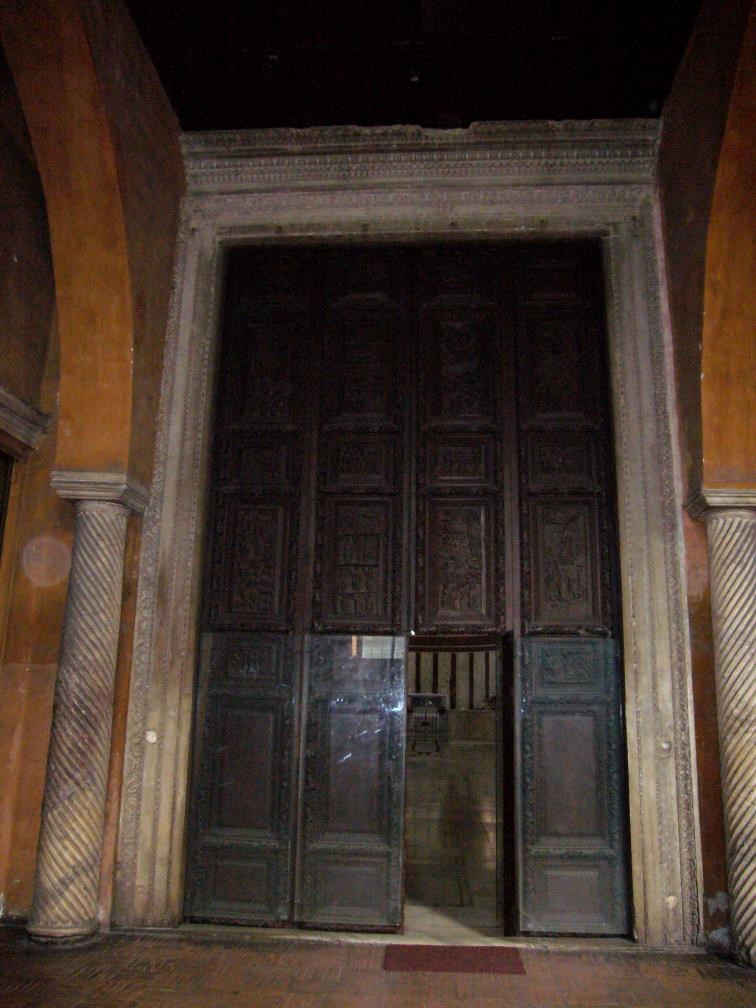
So
we see for example the sarcophagus of the early Christian
art:
663
Sarcophagus of a married couple, Lateran Museum, out of the
4th Century.
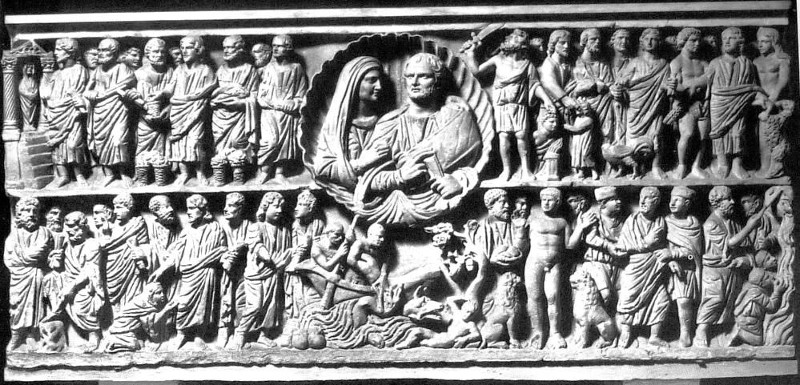
In
the centre is the married couple to which the sarcophagus is
dedicated, presented in portraits, then the two rows above and
below of biblical scenes from the Old and New Testaments. It
starts, as you can see, at the left top with the resurrection
of Lazarus. You then see the continuation, to the right of the
rounding shell, the sacrifice of Isaac, continuing further one
recognises the betrayal by Peter. Below, right, you see for
example — they are all biblical figures — here it is
unfortunately too small — above and below are Bible scenes. We
see what Greek art created up to its culmination, the free
standing human figure, which here has to be squashed into
reality, but reality connecting this world to the world of the
afterlife. So we see the figures lined up. Here we see the free
depiction obviously impaired, this impaired composition is
exactly what we want to look at in particular. In this example
we have for example a sarcophagus configuration, an extraction
of the materials in form, as an example of an entire
composition pressed into it. Please look carefully, the entire
composition is compressed and composed of human forms. Overall
we have physical forms: Moses, Peter, the Lord Himself, Lazarus
being awakened, Jonah there in the centre; thus we have the
composition, possibly reducing spatial depiction, the geometric
figural moving back to allow the refinement of human form. I
ask you please to particularly consider this because we shall
see quite different things in the following sarcophagus.
Already here you see that not everything is pressed into the
human depiction, these are only one behind another, but look at
the centre, below, how in the Jonah scene composition comes
very obviously to the fore.
664
Sarkophag Ravenna, Dom
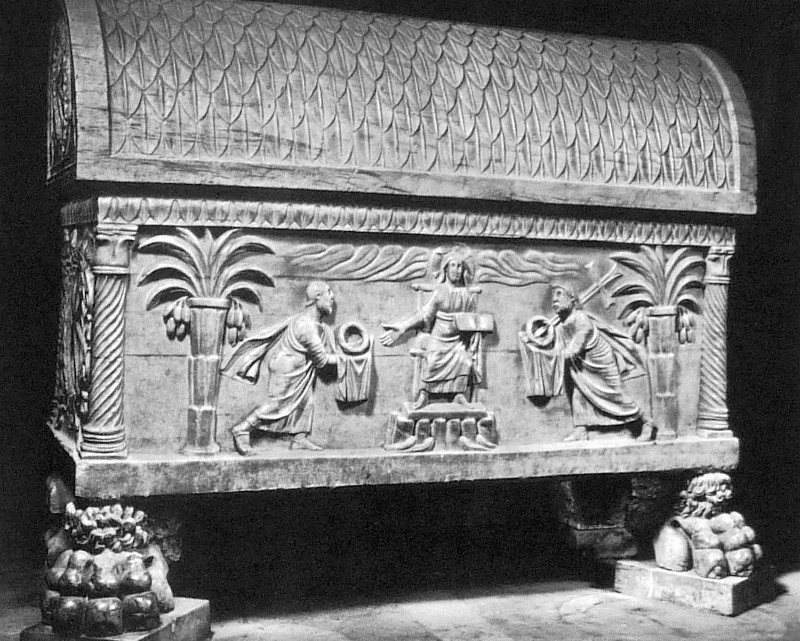
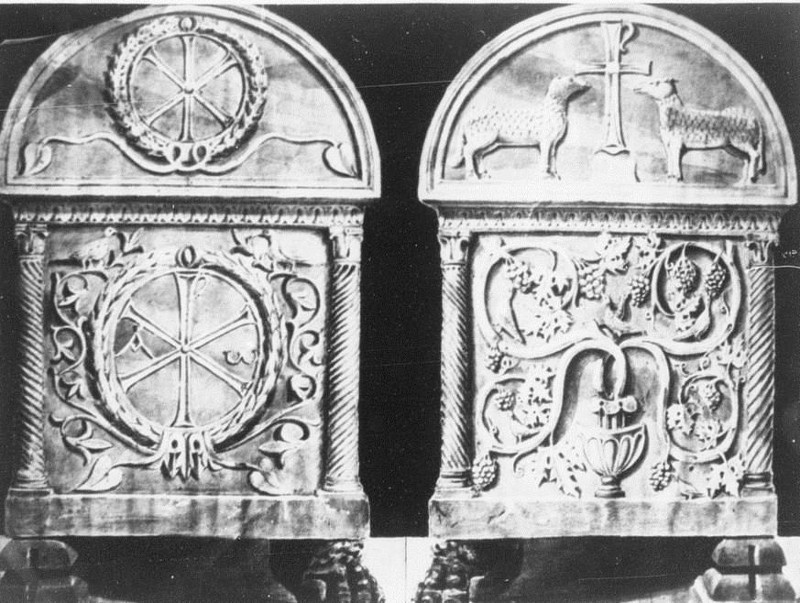
The
central figure: the Christ. Notice how the two other figures
are produced, and behind them the plant motifs on both
sides.
Do
you remember the very first lecture which I held here in
Dornach, in which I tried to show the motifs of the acanthus
leaf, how it didn't grow as a copy of nature but came out of
geometric form, out of an understanding of guidelines and only
later, as I showed, did it adapt itself to the naturalistic
acanthus leaf? So we see, like here (667) lines and line ratios
build a kind of central theme ... and how to some extent the
pictorial, which Hellenism brought to its highest expression,
now recedes and becomes threaded into the compositional. We can
say we have vertical lines, then two opposing angular lines and
a centre. When we draw these lines we start to consider spatial
relationships:

Let
us then add two plant motifs and two figures — ostensibly
filled with reverence — rushing towards the centre

We
see that it is possible to say that the symbolic image becomes
connected with something which can only be suggested as
naturalistic because naturalism itself is idealistic: the human
figure or even the organic being and the symbol are interwoven
and become hardly distinguishable from one another.
We
shall see that quite other, quite different motifs will come to
meet us in other sarcophagi as for example with the following
one.
666
Sarcophagus, 4th Century, back section of the Exarch
Isaac. Ravenna, S. Vitale
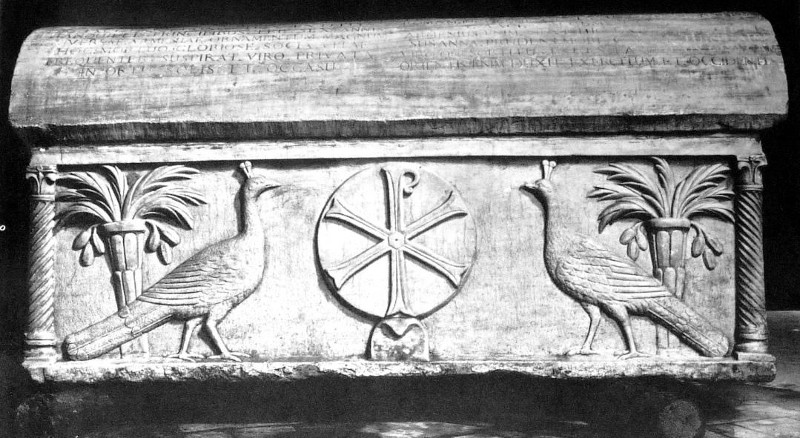
Here we have something quite different. Here we have admittedly
also plant motifs; you have the same lines — now not with human
beings — but filled in with animals. You have the central motif
but this motif itself is symbolic; this motif is a sign, a
monogram of Christ, Chi (X) and Rho (P);
therefore, Christ construed as the Wheel of Life in the centre.
Considered spatially this composition is the same as the one
before. Instead of the central Christ figure we have the Christ
monogram in the centre; instead of the two figures approaching
in reverence, we have animals; and on the sides, plant motifs.
Yet, in a remarkable way, we see the image formed here as more
complete.
The
basis of such a monogram representation is always linked to an
ancient view but in today's opinion may appear somewhat
bizarre, yet that is the basis of it. You must clearly
understand that people had some knowledge, even before
atavistic Gnostic wisdom — which only really withered in the
18th Century, some even as late as the
19th century. When you take this presentation (666)
then you will easily find yourself entering into the artwork
despite the naturalistic drawing: the stone as such — physical;
the plant motifs left and right — etheric; the animal motif -
astral; and the monogram of Christ in the centre — the
indwelling of Christ in the “I”.
When we gaze as such signs, at the imagery, the naturalistic
images shown in such signs, we see an interplay coming out of
the 3rd into the 4th post-Atlantean
epochs. What were the most profound characteristics of the
3rd post-Atlantean epoch? There where it really
acted out of its own impulses, this 3rd
post-Atlantean epoch mainly strived to find the sign, the
actual symbol which works magic. Understand this well: the sign
which works magic. The symbolism was there and gave birth to
script. Remember how within the Egyptian culture the priest was
handed the letters through the god Hermes himself, the revealed
words were received from above. These sign were revealed from
the supersensible by the sensible. The signs were to reappear
as something in the sense world which had come out of the
super-sensible as a Christ impulse because the Christ impulse
had to speak not merely of outer manifestations but the Christ
figure had to represent the embodied Apollo. The Christ impulse
had to present the Christ in such a way that it could be said:
“In the beginning was the Word” which means that
the sign originated in the heights of heaven, and has come
down, “and the Word became flesh”.
Thus we need to bring together what lived in the signs as
impulses in the 3rd post-Atlantic times with the
Christ impulse living in the 4th post-Atlantic time.
In Egypt during a relatively earlier time signs could be
transformed into script; we see also in northern countries
signs in the runes are charged with their own magic, and the
rune priests who threw the runes tried to read them, tried to
recognise what revelations the runes revealed from spiritual
heights. Thus we see the influence of the runes in the
3rd post-Atlantean time, runes which can be found
way back in all the centuries before Christendom. This
propagated and streamed together with the naturalistic,
Hellenic presentation, then already presented out of nature by
spiritually beautiful people. Both streams merge. This we can
see in the motif (666) as coming together. This is most
important here: the grasping of one over the other, the flowing
together of the 3rd and 4th
post-Atlantean epochs.
Look at the next motif, the “Presentation of the
Offerings of the Kings”:
667
The other longitudinal side of the sarcophagus of 666, in
Ravenna, Cathedral …
...
we see how the expression of the linear lives beside the
naturalistic reality.
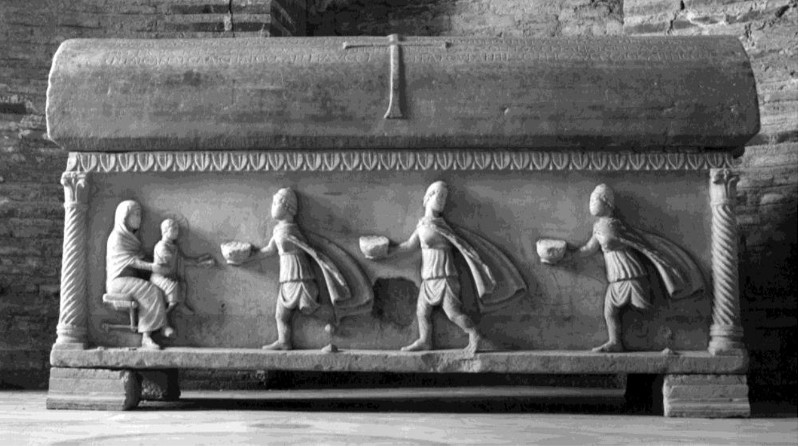
Let
us look at the next sarcophagus motif:
668
Sarkophagus Rome, Lateran-Museum
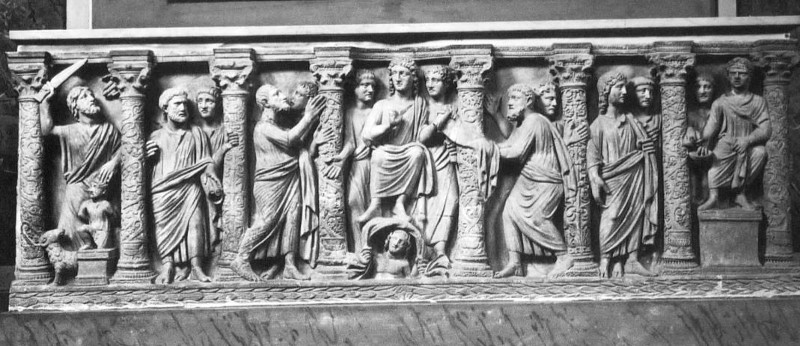
Once again we have something else, despite the succession of
the figures which mainly present a biblical scene, although we
have the figures simply in a row we see how an attempt was made
in the movement of the linear quality of the figures, how the
spatial aspect is expressed. So this again is done in the other
way (like 664).
The
following motif is from the sarcophagus of the grave of Galla
Placidia:
669
Sarcophagus in Ravenna, Mausoleum.
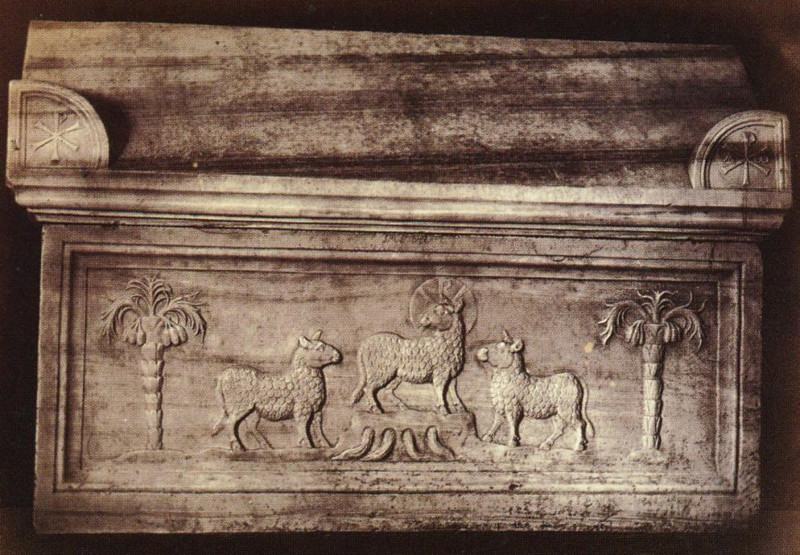
Here the spatial aspect is expressed to a strong degree yet we
only see the same thing we've often encountered before (664,
666), the secret of multiples of five you see expressed here,
in the centre is the Lamb this time — one could say the Lamb is
supported by others — and once again the plants close off the
periphery. In the most diverse ways the spatial artistic
element of the 3rd Post-Atlantean time will support
Christianity, and again penetrate it, as a support for
Christianity. All that comes as sarcophagus art.
I
ask you to really hold on to the idea that the basis of these
signs was allowed to flow into Christianity, secretively: you
have the pentagonal, you have the triangle in the centre, again
a sign; besides this you have the line as I explored earlier.
Why did Christianity allow these signs to flow into it? Because
they saw magic within the signs, magical effects which did not
only happen in the naturalistic area where it became blurred,
but worked through the supersensible; within the signs a
supersensible expression came about.
The
next motif:
670
Sarcophagus in Ravenna, Saint Apollinaire in Classe.
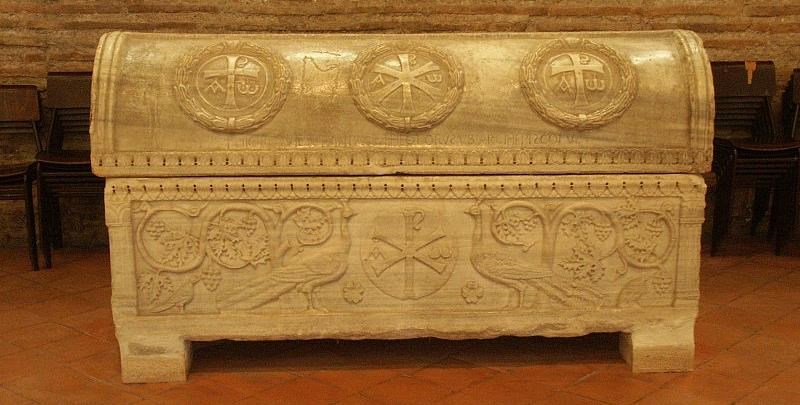
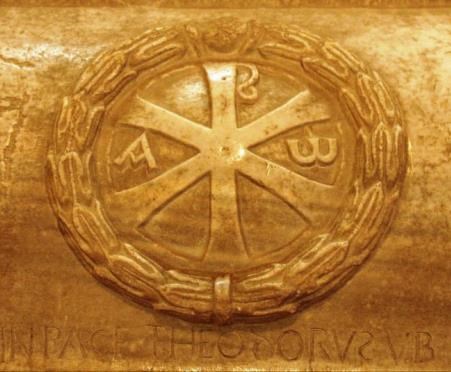
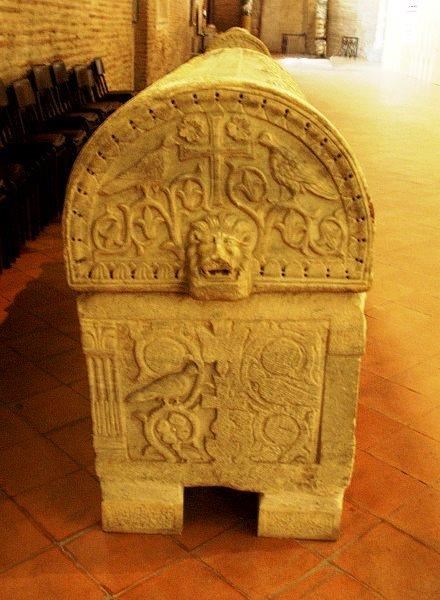
Here we see the signs again mixed in a particular way with the
naturalistic elements: the monogram of Christ in the centre and
the two animal figures which you have seen already, on both
sides. However, the plant motifs are designed in multiples.
Above you can see the sign applied. Here you have signs and
naturalistic depictions intermingled, the signs as magic, the
signs which originate from the same world if they are depicted
meaningfully, which the dead enter at the portal of death. One
felt something like this: out of the world into which the dead
enter at the portal of death these signs come, they are
transformed into script. The naturalistic element however
exists there where humanity lives between birth and death.
The
next motif is the Miracle of the multiplication of Bread:
671
Sarcophagus front angle, 4th Century (Museum of
Arles).

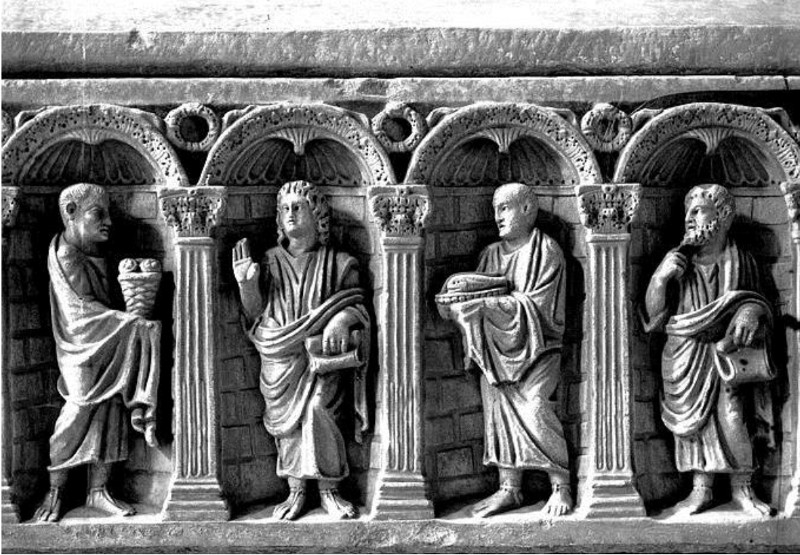
Here in contrast is another way (663, 338) where the mere
architectural has inserted the signs.
The
following is not a sarcophagus motif but is an ivory
carving.
672
Relief 6th Century — Byzantine Emperor, part of a
diptych, central panel, relief (Paris, Louvre)
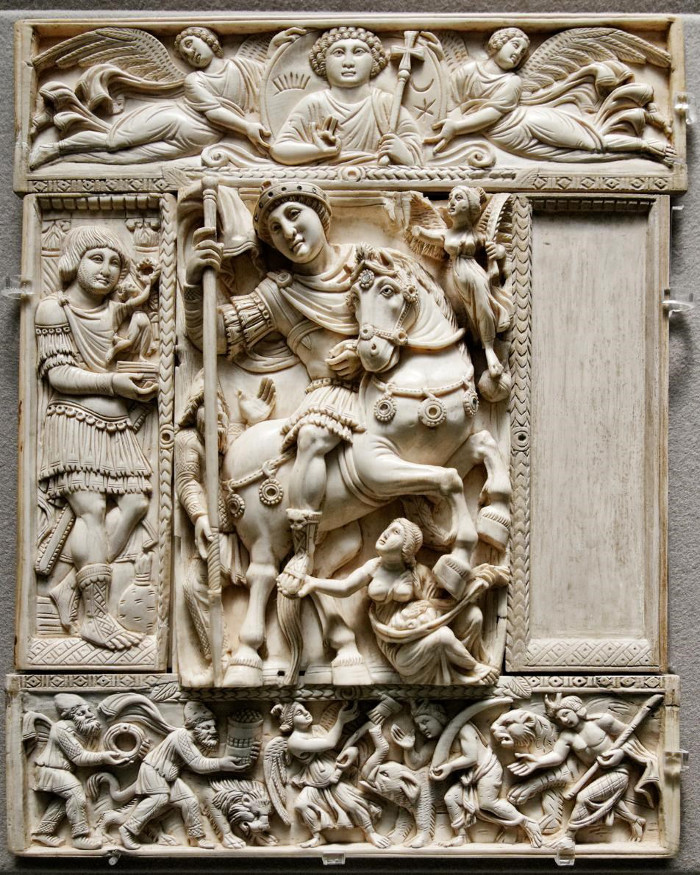
With this I want to make a definite point regarding the way the
material was worked in the same way it had remained in the art
of the 4th post-Atlantean epoch. The manner in which
it was created out of the ivory as relief art during the first
Christian centuries was a capability of the 4th
post-Atlantean time when naturalism was expressed
artistically.
The
following motif is likewise an ivory carving:
673
Ivory relief of Mary and the Child (Berlin, Kaiser Friedrich
Museum)
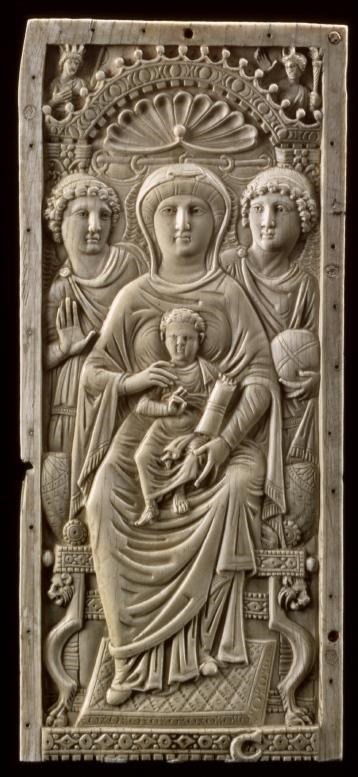
Here you already see likewise more signs complimenting the
lines as well as the figures and images being applied to the
imagery, you can clearly see how it is possible to fill to a
certain extent the area into which the figures are threaded,
pulled in, how they can be expanded as geometrical figures.
These are, one could say, the backbones which Christianity has
brought in the form of the symbolic art of the 3rd
post-Atlantean epoch and which we see appearing everywhere.
I
have another example out of the Dome in Ravenna:
665
Sarcophagus of the holy Rinaldus, the narrow side of 664

...
in which I can show how completely the motifs are converted by
the application of the signs. On the left at the top we have
the Christ monogram, below left and right we again have
geometrical and figurative motifs, above in a similar fashion
the Christ monogram, a simple motif, symmetrical left and
right. We can, if we get a bit of help from our imagination,
see how a real evolution has taken place from the first to the
second motif. Just imagine in the top left under the curvature,
the Chi (X) and the Rho (P), the
Christ monogram simplified, think of the Chi crossbars
simplified and then you arrive at the central motif, top right,
as the monogram forming the cross. Imagine the growing together
of the monogram at the top left, with the wreath, a mere plant
motive of creeper with leaves, and you will come to the animal
motif on the left and right. Simultaneously you could imagine
the top right motif in a simplified and more elevated
configuration as the evolution of the left motif. In the same
way the right sided monogram can be a forerunner of the left.
Just imagine for a moment the left palm of the monogram
configured in these entanglements around the monogram, consider
how the left motif is similarly growing here as is apparent in
our (Goetheanum) Building, where column motifs develop out of
one another; consider the simplified geometric forms more
organically depicted, then you have the right side motif as it
develops from the left one.
When one goes back into the mysteries of the 3rd
post-Atlantean epoch, you find spread all over Europe, from the
north and even into America — because there has always been a
connection between Scandinavia and America which was only lost
for a short while, a few centuries before America was
discovered by Spain, much earlier one always sailed from
Scandinavia to America; they lost their connection for a short
while and it was only re-established after Columbus
rediscovered it — one finds, spread out over southern Europe,
over North Africa, over familiar regions of Asia, the front
area of Asia in particular in the 3rd post-Atlantean
epoch of the Mysteries, afterwards some latecomers — one finds
the real mystery centres of earlier, of the third
post-Atlantean epoch. Here magic and signs were spoken about in
particular. What Egyptian mythology related in regard to the
priesthood of Hermes are the outer exoteric echoes of the
esoteric elements in the Mysteries regarding the magic of
signs, which was learnt in northern lands as the magic of the
runes. This was the magic which came, on the one side, from a
spiritual side, from magic which was used to try and form signs
which came forth purely out of the spiritual realm and to some
extent permeate this realm of signs by human will in order to
create particular signs into which the forces of the
supernatural would be poured.
This was not the only place where magic was searched for. It is
very significant that magic was looked for on the other side,
one could say, in the supernatural. Isn't it true that the
naturalistic as well as art was simultaneously spiritual for
the Greeks? In supernatural signs magic was searched for which
merely lay within the signs themselves. However, magic was also
sought in sub-nature. Besides the mysteries which speaks about
the runes and signs in olden times, there were other mysteries
which spoke about other riddles regarding sub-nature. This
sub-nature one discovers in quite particular products when one
looks for them mainly under the surface of the earth. If one
goes above then one meets the gods in the heights who give
sense to the signs, where the supersensible works as magic,
then it is possible to grasp it in the sensual sense and unite
it artistically. If one goes however into sub-nature, into the
inner earth, one finds a kind of magic held there.
Among the manifold magical things, one sought in particular for
the identification of two riddles. If we today express the
knowledge of these two riddles, we could say that in the secret
mysteries the riddle of gold was well kept, as it is sought in
the veins of the earth, and also the riddle of gemstones. This
sounds extraordinary but it really correlates historic fact.
The magic of the signs was particularly connected to the
church. In the 3rd post-Atlantean time they sought
to incorporate magic into the signs. The magic of gold — where
in particular it is formed as it appears in nature — and then
the magic of gemstones which bring light into what had been
dark, where light is held in something material, material which
was held in darkness — this didn't enter into the priesthood
but gave itself into the profaneness of humankind who stood
outside the church.
So
it happened that out of certain impulses which were very, very
old — when liberated town culture established itself in art
which I have just recently explained, as everywhere the
liberated town teachings developed, that these liberated town
developments came to the surface -the joy of gemstones, the joy
of gold, the delight in gold processing and the delight in
precious stone application came through as waves in the
spiritual life. Just as the church wanted to bring signs out of
the heights of heaven so from the depths of the earth came the
secret of gold and the secret of the gemstones as part of the
liberated town culture. Not just by coincidence, but through
deep historic necessity the art of the goldsmith developed and
I would like to say, only as an annexure to the goldsmith art,
other metal art grew out of the desires of town culture, by
applying gemstones, because gold and gemstones contained magic,
a magic from below in nature that should be loosened and spread
before the senses.
Still today an echo of this urban working with gold and
gemstones can be seen in art, as founded by the Bishop
Bernward of Hildesheim. In Hildesheim, situated in the
midst of northern Europe's centre one sees many such works of
art — otherwise also available but particularly concentrated
there — where gemstones are incorporated into the most delicate
artistic metallic works of art.
Bernward of Hildesheim
674
The Bernward Cross (Hildesheim, Church of Magdalene)
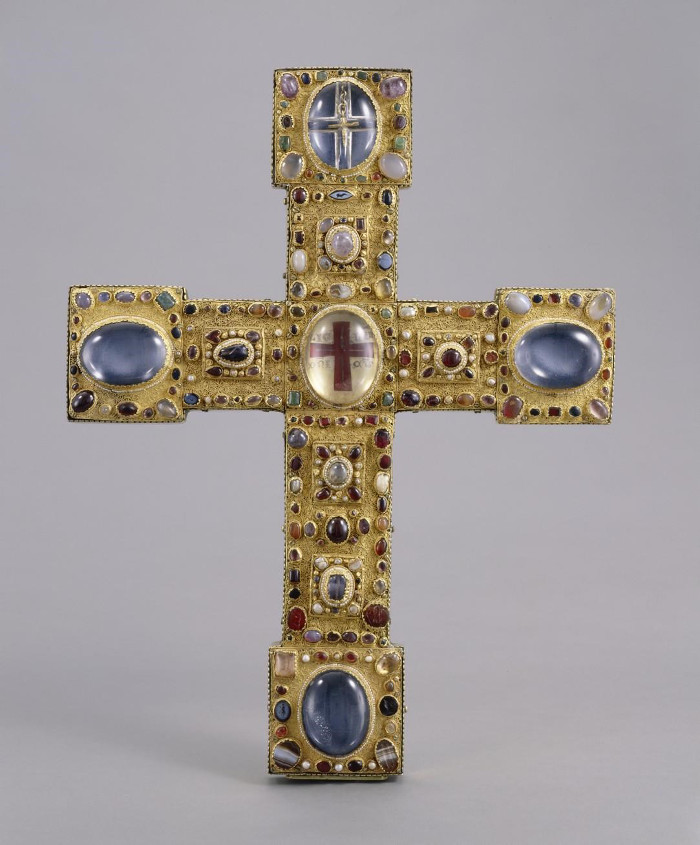
675
The Bernward Cross, rear view
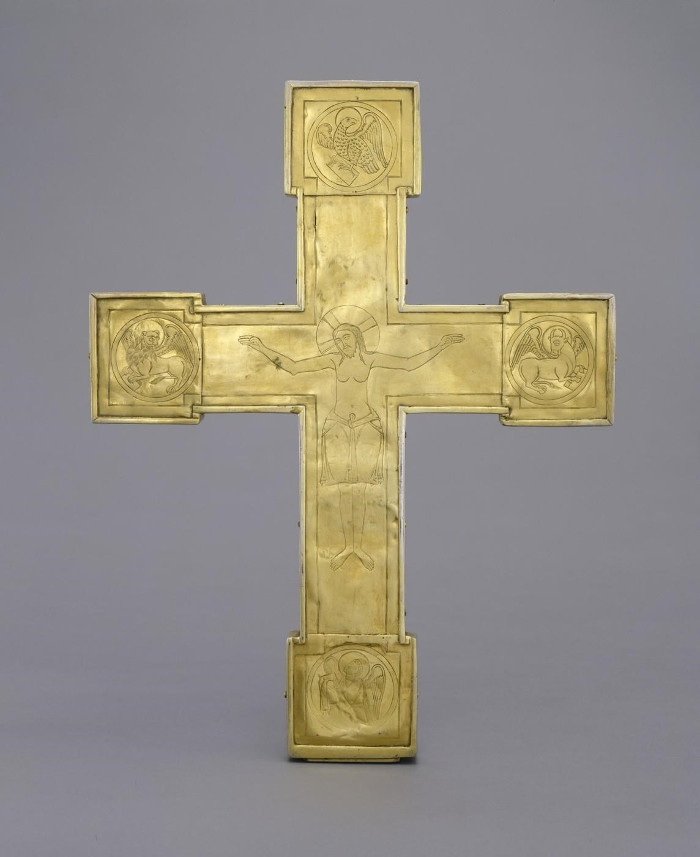
676
The Bernward Chandelier (Hildesheim, Church of Magdalene)
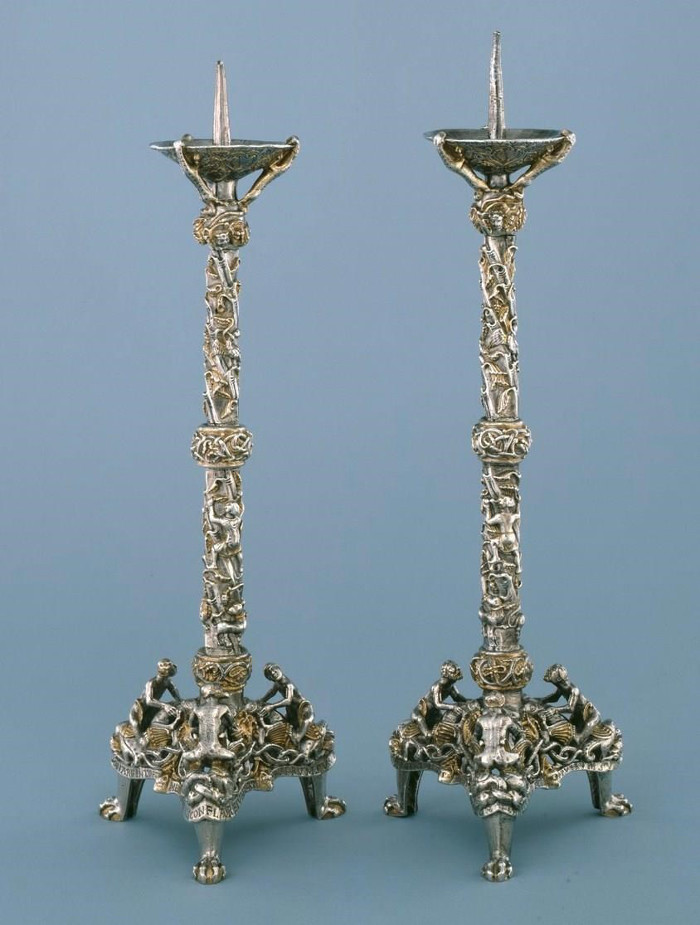
677
Cover to one of the Gospels (Hildesheim, Dome)
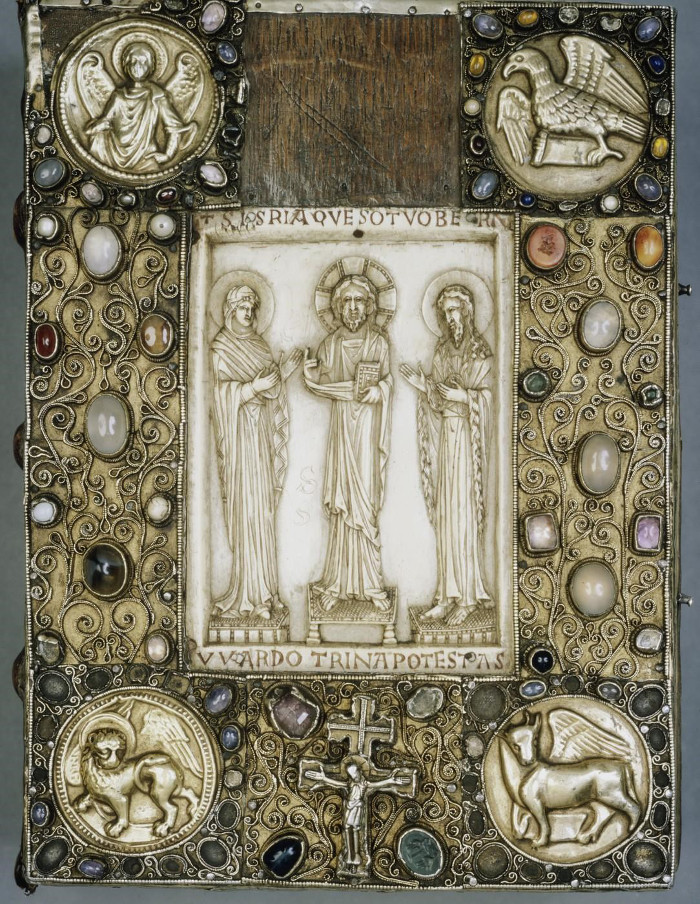
In
Hildesheim it comes across to one as phenomenally important in
its ancient form. It spread out, and actually this which I have
pointed out as appearing and blossoming particularly because
Central European impulses are also found in Italian cities.
Basically the art of the goldsmith in Florence and what was
designed by later goldsmiths to become the great art in the
arena of sculptural relief and sculpture as such, dates back to
this same origin. These things are interlinked in the most
manifold ways.
Now
consider the following. I had said that in the 9th
Century when the church of Rome and the papacy had a different
understanding than later, of what actually had to happen in the
western world, from a certain viewpoint I represented this, how
from the 9th Century onward forces in Rome, which
one could say rose from below and became valid, how these laws
from Rome became systemized just like laws originating from the
spiritual world should have been included. On the one side Rome
can seem thus: from the South rose the magic and sign world
which came from above but with a focus towards the North where
liberated town culture was being developed, focussing towards
the North where joy grew in the secret of gold, in the secret
of gemstones. However, this northern influence had already
produced something out of its old mysteries, which necessarily
had connections through the mysteries to, on the one side, the
mystery of gemstones — this we can leave out of the game today
— and on the other side, connections to the mystery of gold.
Christianity didn't simply develop out of a single impulse and
impulses also worked against Christianity. Just as it was
opposed in the South by the magic of signs, so in the North it
was opposed by the world of Central European legends and out of
the North incorporated by the great gold mystery, as
illustrated.
With the gold mystery the figure of Siegfried is connected, who
looted gold and perished through the tragedy of gold.
Everything which is connected to the Siegfried figure is
related to the mystery of gold. The theme that gold and its
magic only belong to the supersensible world is like a red
thread throughout the Nibelungenlied, gold is not to be
dedicated to the sense world.
If
one considers it in this way, then your mind understands the
deepest mystery of gold. What did Siegfried's friend tell him?
What does the Nibelungenlied say? What is its great teaching?
Offer the gold to the dead! Leave it to the supersensible
realm; in the sensible world it makes mischief.
That was the teaching which propagated through Christianity in
the northern countries. This is what was understood in Rome
during the great synthesis taking place between Roman elements
of the 9th Century in the northern European areas
when within art it united with what rose from the one side out
of signs and on the other side from symbols added into the gold
and gemstone work. How beautiful this confluence of symbol-rich
art and gold-gemstone art is during the 8, 9, 10, 11,
12th centuries. Everywhere we see this ancient
Christian art of symbols. By connecting other impulses, we see
the incorporation of the symbols into the working of the gold
and gems.
This was now systematically sought in Rome, but was also
prepared for in Europe. As a result in the early days we see,
rising from the south, the Christian traditions in a form that
even in a non-pictorial, purely by word-of-mouth form, the
symbols moved and worked. The heathens coming from the North
were heralds of everything worldly, embellished, and
ornamental, linking the magic of the symbols to the sub-nature.
By associating the cross of the South with the gold and gems of
the North which originated in the heathen mysteries, just like
the symbol of the cross itself out of the mysteries is applied
to the Mystery of Golgotha, so we see three impulses combining:
the naturalistic depiction of spiritualised nature taking the
Greek power of form from the 4th post-Atlantean
epoch, and the other two impulses: the symbol of the magic in
signs, and the magic of sub-nature, of gold and gems.
Yes, to find the preparation of ancient times in the historic
development of becoming, the further back we need to go. Our
time is already in the epoch in which, I might say, everything
battles with the human being, in order for him to learn and not
remain sleepy by gazing into the present, but that lively
impulses of evolution are really grasped, otherwise he might
nevermore be forced to see how chaotic the present has
become.
Today I have the opportunity, but in the near future this
opportunity might not be so, to show you how, by the art
influenced by the South being brought towards the North, that a
particularly strong motif is expressed by the merging of the
animalistic and human. In earlier time this started to appear
and later became seen as the interworking of darkness and
light. Out of the figurative dark animalistic realm the bright
human form rises in the relationship of the dragon with
Michael, and so on, also seen in other compilations of the
animal and human. This becomes the light-dark artistic
expression later. All these things are interconnected. Much,
very much has to be spoken about if one wants to show the
artistic expression of this interworking between the olden and
newer times, this penetration of the naturalistic heathen
impulses with the Christian impulses, which however, to be
valid, has to renew the old magical motifs, now to have this
magic in the old heathen sense undressed and lifted up into the
real spiritual world.
This was known particularly in the 9, 10, 11, 12,
13th centuries. It was then known that the ancient
heathen elements had become obsolete, but lots remained behind
— yet these elements had become old — and that the young
Christianity of that time had to work into this, was known.
This we meet in literature, in art, in the creation of legends,
everywhere. I have already often pointed this out, how present
time humanity has become completely lost to the idea of
spirituality working in outer reality. In the 5th
post-Atlantean time when materialism is written on people's
banners, this idea has nearly become lost completely. People
are unable to imagine the streaming in of the spiritual, of the
meaningful elements in pure naturalism, in pure matter. As a
result, the gradual dying of the heathen and the gradual
becoming of the Christ impulse in European culture is
considered, at best, in abstract terms. In the 9, 10, 11, 12,
and 13th centuries this was not the case. Then one
presented it, if a representation was wanted at all, in such a
way that the soul and outer corporeality were considered
simultaneously as outside of the human being in history and in
natural events. Everywhere one looks at the physical
geographical surroundings something spiritual is simultaneously
expressed. Hence much in the prophetic line came to be seen in
these ideas.
People at present, if they do not only want to have superficial
feelings but have a heart for the monstrous events taking place
in our time, cannot today think of the Nibelungen legend
without seeing prophetic depths within it. Whoever understands
the Nibelungen legend in its depths, feel prepared for all the
terrible events which flash through the present. By thinking in
the same way in which thoughts are shaped in the
Nibelungenlied, one thinks in a prophetic manner because then
thoughts are formed through the mystery of gold. Hagan allowing
the Nibelungen treasure, the gold treasure, to sink into the
Rhine, was a prophetic idea at the time the Nibelungen saga was
created and is experienced as deeply tragic in view of the
future, on all that the Rhine will become as a cause for
antagonistic impulses against the future. At that time the
outer geographic natural world was not regarded as soulless,
but was seen in connection with the soul, in every breath of
wind was a soul quality, in every flowing stream something of a
soul. At that time, it was also really known in what sense the
purely materialistic reference meant regarding “the old
Rhine River”. What is the Rhine actually in a
materialistic sense? It is the water of the Rhine. What flows
in it these days will in future be somewhere else. The water of
the Rhine is actually not really something one can call the old
Rhine, and one does not usually think of the mere coincidence
of the earth. All that is matter flows on, it doesn't remain.
In olden times external matter was given no thought, other than
everything being an illusion; it was not believed that external
events were merely embedded in the flow of what was described
as naturalistic. Whatever was external was simultaneously a
soul expression permeating physical existence. For this reason
and particularly during this time it was a necessity to allow
the old heathendom to dissolve and allow the new introduction
of the Christian impulse — that was necessary in Europe in the
later centuries — there people tried to think soulfully about
geography, making geography plausible to the soul, the heart,
to the mind.
Let
us look at the example of the Odilienberg there in the Vosges
and see the Christian monastery of Odile, to whose father, the
pagan Duke, she was born blind; we see on this site the pagan
walls of the Christian monastery. These pagan walls are nothing
other than the remainders of old pagan mysteries. We see a
merging of dying paganism and the rise of the Christ impulse at
this geographic location. We see this expressed in the myth
with remnants of the own pagan ancestry imposed by Odile being
blind but who becomes inwardly, spiritually seeing through the
Priest of Regensburg, through a Christ impulse. We see a
working together in Regensburg a blossoming later as in the
great fruitfulness of Albertus Magnus, we see it blooming, we
see it instilling the Christ impulse in the eyes of Odile whose
pagan ancestors had blinded her. We see geographically at this
place the telescoping of the Christian light into the old pagan
darkness. We see this as the basis imposed by Rome: take up the
gold, but bring the gold as offering from the realms of the
supersensible. Let the gold enter into that, of which the Cross
is a sign! In our time we see by contrast, the flood of gold
taken up by the senses as it was brought into expression in the
old heathen legends.
We
see how time takes a stand of opposition to the supersensible
light contrasted by the gold. Siegfried was drawn to Isenland
to fetch the Nibelungen gold. The Nibelungen gold he brought
was offered to the Christ impulse. This Christ impulse dared
not turn pagan again!
Oh,
one could use many, many fiery words, as human words are, to
really depict the terrible sense of this time. This time is
filled with signs. During this time human ears unfortunately
wanted to hear very little. The first year of chaos arrived -
and it was believed that it would soon be the past. They didn't
want to listen to the deep powers moving within this chaos -
also into the second, the third year — and also now. Firstly,
when this adored gold can be eroded, will people have ears to
hear that no ordinary tools can be found which are so needed
during this time, tools brought over from the past, but that it
is only possible with the forces of renewal brought about from
within the flowing Christ impulse, which in many cases had
already been forgotten as Christ impulses. In no other way
could these things improve than if as many people as possible
decided to learn from the spirit.
Let
us look for once at the manner in which earlier humanity
comprehended things, even thinking of the direction of the wind
not in a materialistic sense but that the windsock was
inspired, ensouled by the region with, on the one side, the
Odilienberg and on the other side, Regensburg. It was the same
with other places.
Learn once again how humanity experienced not mere air moving
over the earth but that there is spirit above the earth, spirit
which must be searched for; that beneath the earth there is not
only stuff which they could take out with the aid of material
tools, but that which was to be unearthed from the sub nature
had to be offered up to the super-sensory. To understand
mankind again, that is the mystery of gold! Not only spiritual
science teaches this but this can also be learnt through the
real understanding of the history of art in a spiritual sense.
Oh, how terrible it is to see how the present day humanity wait
day after day and do not want to understand the necessity to
grasp the new; that they make no progress through old, worn-out
imaginations. More about this again at another time.
|